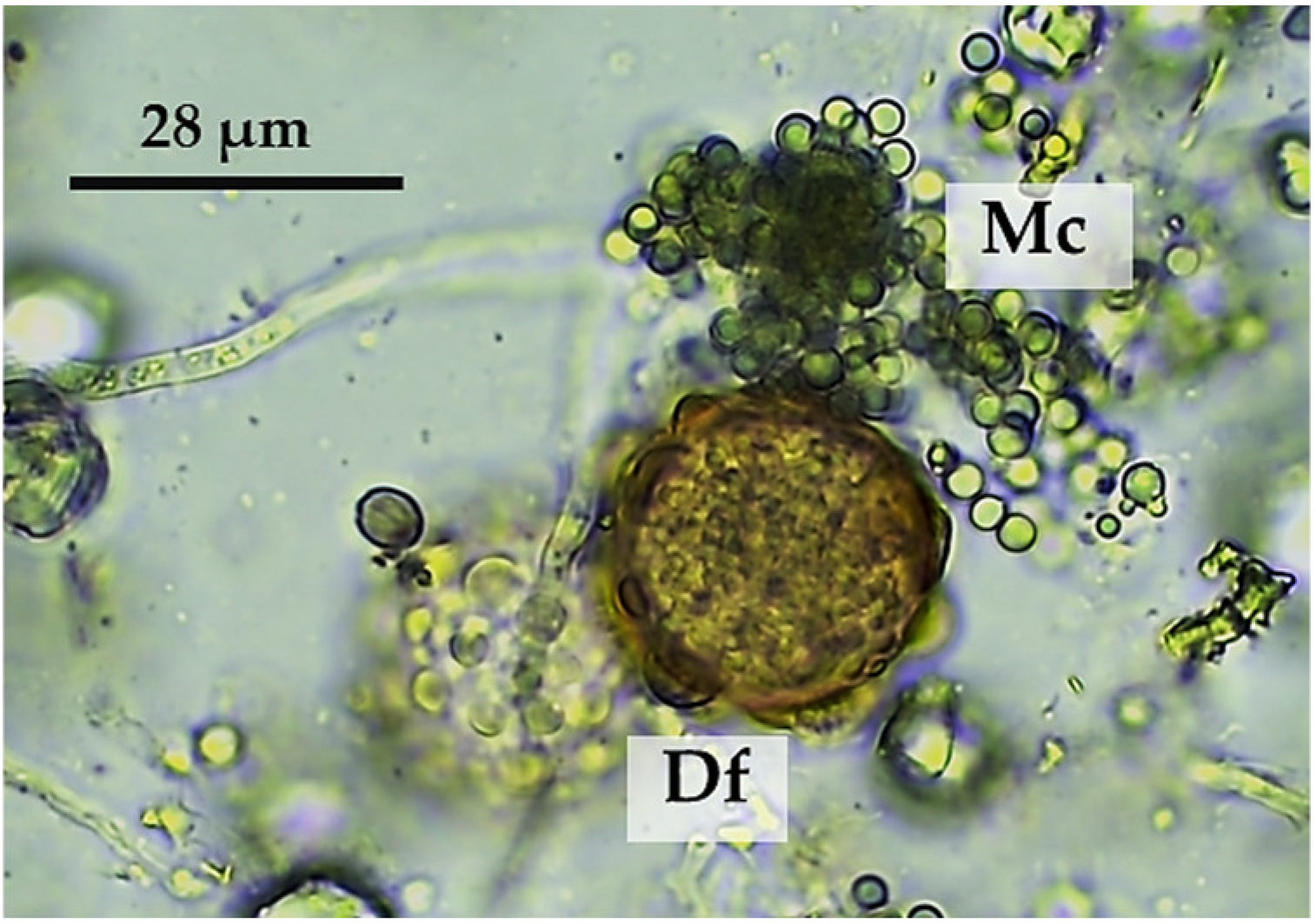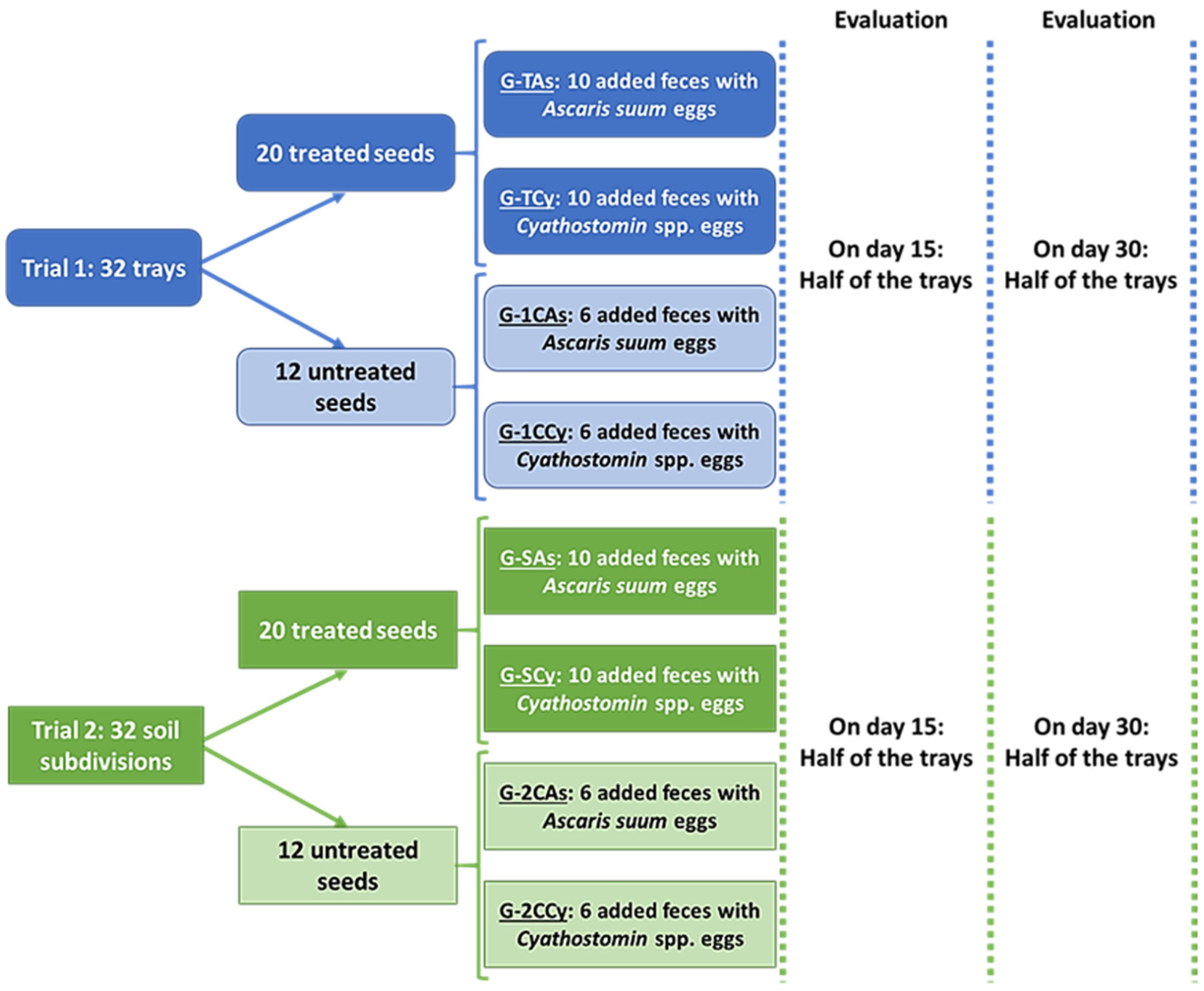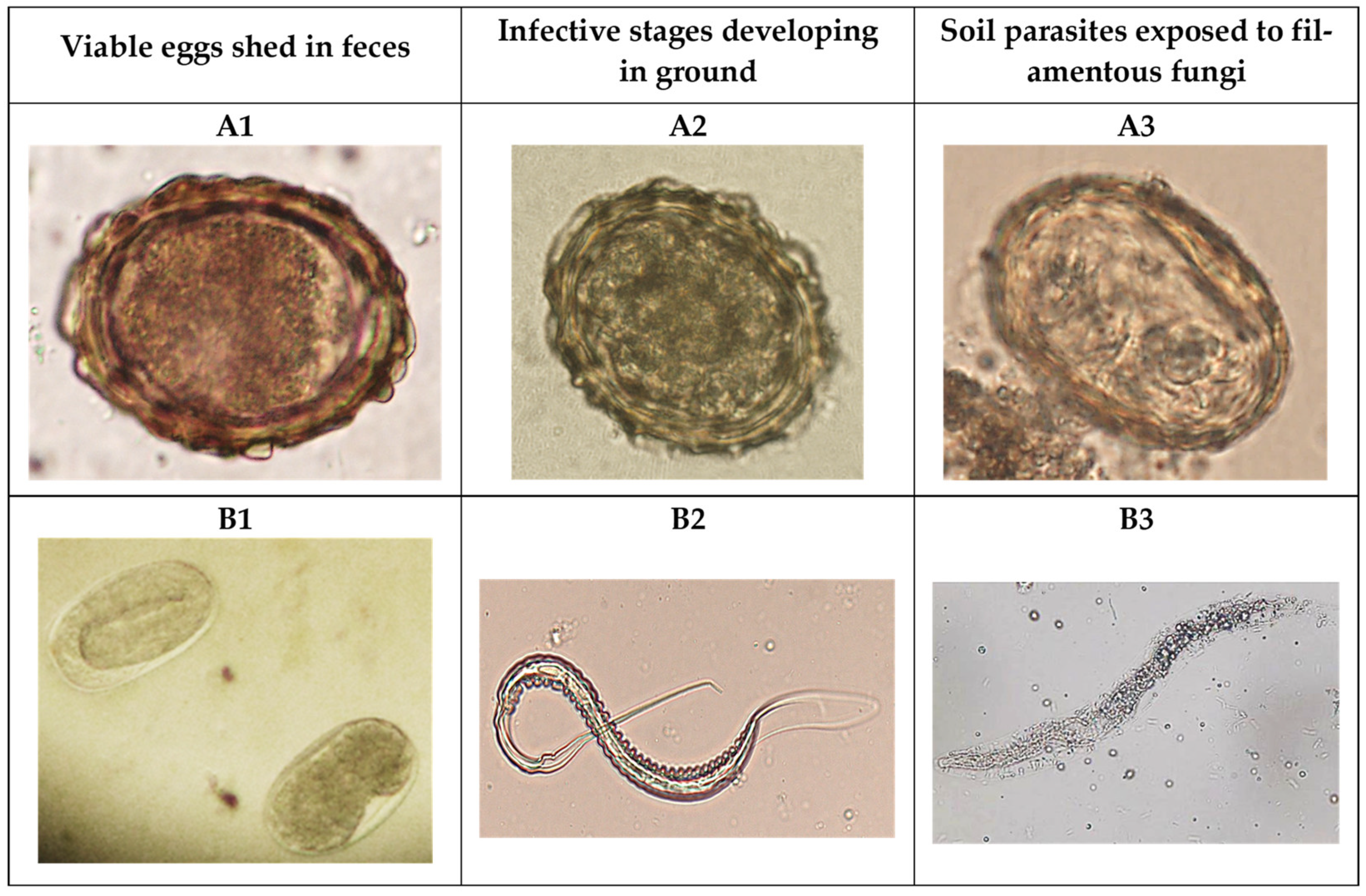A New Soil-Based Solution for Reducing the Persistence of Parasites in Zoos
Abstract
1. Introduction
2. Materials and Methods
2.1. Parasitophagous Fungi
2.2. Preparation of Forage Seeds for Sowing
2.3. Evaluation of the Antiparasitic Effect
2.3.1. Roundworms
2.3.2. Cyathostomins
2.4. Statistical Analysis
3. Results
3.1. Effect on Eggs of A. suum
3.2. Effect on Cyathostomin Third-Stage Larvae (L3s)
4. Discussion
5. Conclusions
Author Contributions
Funding
Institutional Review Board Statement
Data Availability Statement
Acknowledgments
Conflicts of Interest
References
- Rabb, G.B. The Evolution of Zoos from Menageries to Centers of Conservation and Caring. Curator. Mus. J. 2004, 47, 237–246. [Google Scholar] [CrossRef]
- Packer, J.; Ballantyne, R. The Role of Zoos and Aquariums in Education for a Sustainable Future. New Dir. Adult Contin. Educ. 2010, 2010, 25–34. [Google Scholar] [CrossRef]
- Conway, W.G. Buying Time for Wild Animals with Zoos. Zoo Biol. 2011, 30, 1–8. [Google Scholar] [CrossRef]
- Mellen, J.D. Zoo Standards for Keeping Small Felids in Captivity. Available online: https://nagonline.net/763/zoo-standards-keeping-small-felids-captivity/ (accessed on 13 February 2024).
- Gonzálvez, M.; Moreno, E.; Pérez-Cutillas, P.; Gilbert, T.; Ortiz, J.; Valera, F.; Espeso, G.; Benzal, J.; Ibáñez, B.; de Ybáñez, M.d.R.R. Zoological Institutions as Hotspots of Gastrointestinal Parasites That May Affect the Success of Ungulate Reintroduction Programmes. Vet. Rec. 2021, 189, e506. [Google Scholar] [CrossRef]
- Capasso, M.; Maurelli, M.P.; Ianniello, D.; Alves, L.C.; Amadesi, A.; Laricchiuta, P.; Silvestre, P.; Campolo, M.; Cringoli, G.; Rinaldi, L. Use of Mini-FLOTAC and Fill-FLOTAC for Rapidly Diagnosing Parasitic Infections in Zoo Mammals. Rev. Bras. Parasitol. Vet. 2019, 28, 168–171. [Google Scholar] [CrossRef] [PubMed]
- Garijo, M.M.; Ortiz, J.M.; Ruiz de Ibáñez, M.R. Helminths in a Giraffe (Giraffa Camelopardalis Xgiraffa) from a Zoo in Spain. Onderstepoort J. Vet. Res. 2004, 71, 153–156. [Google Scholar] [CrossRef]
- Atanaskova, E.; Kochevski, Z.; Stefanovska, J.; Nikolovski, G. Endoparasites in Wild Animals at the Zoological Garden in Skopje, Macedonia. J. Threat. Taxa 2011, 3, 1955–1958. [Google Scholar] [CrossRef]
- Nath, T.C.; Eom, K.S.; Choe, S.; Hm, S.; Islam, S.; Ndosi, B.A.; Kang, Y.; Bia, M.M.; Kim, S.; Eamudomkarn, C.; et al. Insight into One Health Approach: Endoparasite Infections in Captive Wildlife in Bangladesh. Pathogens 2021, 10, 250. [Google Scholar] [CrossRef] [PubMed]
- Hernández, J.A.; Cazapal-Monteiro, C.F.; Arroyo, F.L.; Silva, M.I.; Palomero, A.M.; Paz-Silva, A.; Sánchez-Andrade, R.; Arias, M.S. Biological Control of Soil Transmitted Helminths (STHs) in a Zoological Park by Using Saprophytic Fungi. Biol. Control 2018, 122, 24–30. [Google Scholar] [CrossRef]
- Paz-Silva, A.; Salmo, R.; Viña, C.; Miguel Palomero, A.; Ángel Hernández, J.; Sánchez-Andrade, R.; Cazapal-Monteiro, C.; Sol Arias, M. Gelatin Treats Containing Filamentous Fungi to Promote Sustainable Control of Helminths among Pets and Zoo Animals. Biol. Control 2023, 179, 105184. [Google Scholar] [CrossRef]
- Salmo, R.; Viña, C.; Lozano, J.; Palomero, A.M.; Hernández, J.Á.; Bonilla, R.; Sánchez-Andrade, R.; Paz-Silva, A.; Madeira de Carvalho, L.M.; Arias, M.S.; et al. Saprophytic Filamentous Fungi against Helminths Affecting Captive Wild Animals. Encyclopedia 2024, 4, 91–100. [Google Scholar] [CrossRef]
- Arias, M.S.; Cazapal-Monteiro, C.F.; Suárez, J.; Miguélez, S.; Francisco, I.; Arroyo, F.L.; Suárez, J.L.; Paz-Silva, A.; Sánchez-Andrade, R.; Mendoza de Gives, P. Mixed Production of Filamentous Fungal Spores for Preventing Soil-Transmitted Helminth Zoonoses: A Preliminary Analysis. BioMed Res. Int. 2013, 2013, 567876. [Google Scholar] [CrossRef]
- Hernández, J.A.; Vázquez-Ruiz, R.A.; Cazapal-Monteiro, C.F.; Valderrábano, E.; Arroyo, F.L.; Francisco, I.; Miguélez, S.; Sánchez-Andrade, R.; Paz-Silva, A.; Arias, M.S. Isolation of Ovicidal Fungi from Fecal Samples of Captive Animals Maintained in a Zoological Park. J. Fungi 2017, 3, 29. [Google Scholar] [CrossRef] [PubMed]
- Cernea, M.; Madeira de Carvalho, L.; Vasile, C. Atlas of Diagnosis of Equine Strongylidosis; Editura Academic Press: Târgovişte, Romania, 2008; ISBN 978-973-744-127-0. [Google Scholar]
- Araújo, J.V.d.; Fonseca, J.d.S.; Barbosa, B.B.; Valverde, H.A.; Santos, H.A.; Braga, F.R. The Role of Helminthophagous Fungi in the Biological Control of Human and Zoonotic Intestinal Helminths. Pathogens 2024, 13, 741. [Google Scholar] [CrossRef] [PubMed]
- VanHoy, G. Overview of Gastrointestinal Parasites of Ruminants. Available online: https://www.msdvetmanual.com/digestive-system/gastrointestinal-parasites-of-ruminants/overview-of-gastrointestinal-parasites-of-ruminants#Prevention_v81479076 (accessed on 18 August 2024).
- Esteban-Sánchez, L.; García-Rodríguez, J.J.; García-García, J.; Martínez-Nevado, E.; de la Riva-Fraga, M.A.; Ponce-Gordo, F. Wild Animals in Captivity: An Analysis of Parasite Biodiversity and Transmission among Animals at Two Zoological Institutions with Different Typologies. Animals 2024, 14, 813. [Google Scholar] [CrossRef] [PubMed]
- Van Tieghem, P. Nouvelles recherches sur les Mucorinées. Fortin Masson 1875, 6, 175. [Google Scholar]
- Chaverri, P.; Branco-Rocha, F.; Jaklitsch, W.; Gazis, R.; Degenkolb, T.; Samuels, G.J. Systematics of the Trichoderma Harzianum Species Complex and the Re-Identification of Commercial Biocontrol Strains. Mycologia 2015, 107, 558–590. [Google Scholar] [CrossRef]
- Schroers, H.-J.; Samuels, G.J.; Seifert, K.A.; Gams, W. Classification of the Mycoparasite Gliocladium Roseum in Clonostachys as C. Rosea, Its Relationship to Bionectria Ochroleuca, and Notes on Other Gliocladium-like Fungi. Mycologia 1999, 91, 365–385. [Google Scholar] [CrossRef]
- Cortiñas, F.J.; Cazapal-Monteiro, C.F.; Hernández, J.A.; Arroyo, F.L.; Miguélez, S.; Suárez, J.; López de Arellano, M.E.; Sánchez-Andrade, R.; Mendoza de Gives, P.; Paz-Silva, A.; et al. Potential Use of Mucor Circinelloides for the Biological Control of Certain Helminths Affecting Livestock Reared in a Care Farm. Biocontrol Sci. Technol. 2015, 25, 1443–1452. [Google Scholar] [CrossRef]
- Viña, C.; Silva, M.I.; Palomero, A.M.; Voinot, M.; Vilá, M.; Hernández, J.Á.; Paz-Silva, A.; Sánchez-Andrade, R.; Cazapal-Monteiro, C.F.; Arias, M.S. The Control of Zoonotic Soil-Transmitted Helminthoses Using Saprophytic Fungi. Pathogens 2020, 9, 1071. [Google Scholar] [CrossRef] [PubMed]
- Rapiya, M.; Hawkins, H.-J.; Muchenje, V.; Mupangwa, J.F.; Marufu, M.C.; Dzama, K.; Mapiye, C. Rotational Grazing Approaches Reduces External and Internal Parasite Loads in Cattle. Afr. J. Range Forage Sci. 2019, 36, 151–159. [Google Scholar]
- Mendoza-de Gives, P. Soil-Borne Nematodes: Impact in Agriculture and Livestock and Sustainable Strategies of Prevention and Control with Special Reference to the Use of Nematode Natural Enemies. Pathogens 2022, 11, 640. [Google Scholar] [CrossRef]
- Hernández Malagón, J.Á.; Filipa Cazapal-Monteiro, C.; Bonilla Quintero, R.; Miguel Palomero Salinero, A.; Isabel Silva Torres, M.; Voinot Messnier, M.; Vilá Pena, M.; Romasanta Blanco, Á.; Pedreira García, J.; Paz Silva, A.; et al. Advantageous Fungi against Parasites Transmitted through Soil. In Fungal Infection; Silva de Loreto, É., Simoni Moraes Tondolo, J., Eds.; IntechOpen: London, UK, 2019; ISBN 978-1-83880-468-8. [Google Scholar]
- Palomero, A.M.; Cazapal-Monteiro, C.F.; Valderrábano, E.; Paz-Silva, A.; Sánchez-Andrade, R.; Arias, M.S. Soil Fungi Enable the Control of Gastrointestinal Nematodes in Wild Bovidae Captive in a Zoological Park: A 4-Year Trial. Parasitology 2020, 147, 791–798. [Google Scholar] [CrossRef] [PubMed]
- Cruz, L.M.; Allanson, M.; Kwa, B.; Azizan, A.; Izurieta, R. Morphological Changes of Ascaris Spp. Eggs During Their Development Outside the Host. J. Parasitol. 2012, 98, 63–68. [Google Scholar] [CrossRef]






| Day | Trays | Small Ground Areas |
|---|---|---|
| 15 | 13.1 | 10.6 |
| 30 | 58.3 | 51.7 |
| Day | Trays | Small Ground Areas |
|---|---|---|
| 15 | 46.7 | 38.1 |
| 30 | 72.7 | 66.0 |
Disclaimer/Publisher’s Note: The statements, opinions and data contained in all publications are solely those of the individual author(s) and contributor(s) and not of MDPI and/or the editor(s). MDPI and/or the editor(s) disclaim responsibility for any injury to people or property resulting from any ideas, methods, instructions or products referred to in the content. |
© 2024 by the authors. Licensee MDPI, Basel, Switzerland. This article is an open access article distributed under the terms and conditions of the Creative Commons Attribution (CC BY) license (https://creativecommons.org/licenses/by/4.0/).
Share and Cite
Hernández, J.Á.; Viña, C.; Lozano, J.; Zubiría, I.; Baena, M.; Abreu-Ramos, I.; Salmo, R.; Valderrábano, E.; Pérez-Anzúrez, G.; Paz-Silva, A.; et al. A New Soil-Based Solution for Reducing the Persistence of Parasites in Zoos. J. Zool. Bot. Gard. 2024, 5, 817-827. https://doi.org/10.3390/jzbg5040054
Hernández JÁ, Viña C, Lozano J, Zubiría I, Baena M, Abreu-Ramos I, Salmo R, Valderrábano E, Pérez-Anzúrez G, Paz-Silva A, et al. A New Soil-Based Solution for Reducing the Persistence of Parasites in Zoos. Journal of Zoological and Botanical Gardens. 2024; 5(4):817-827. https://doi.org/10.3390/jzbg5040054
Chicago/Turabian StyleHernández, José Ángel, Cándido Viña, João Lozano, Izaro Zubiría, Miguel Baena, Inês Abreu-Ramos, Rami Salmo, Esther Valderrábano, Gustavo Pérez-Anzúrez, Adolfo Paz-Silva, and et al. 2024. "A New Soil-Based Solution for Reducing the Persistence of Parasites in Zoos" Journal of Zoological and Botanical Gardens 5, no. 4: 817-827. https://doi.org/10.3390/jzbg5040054
APA StyleHernández, J. Á., Viña, C., Lozano, J., Zubiría, I., Baena, M., Abreu-Ramos, I., Salmo, R., Valderrábano, E., Pérez-Anzúrez, G., Paz-Silva, A., Muíño, R., Cazapal-Monteiro, C., Arias, M. S., & Camiña, M. (2024). A New Soil-Based Solution for Reducing the Persistence of Parasites in Zoos. Journal of Zoological and Botanical Gardens, 5(4), 817-827. https://doi.org/10.3390/jzbg5040054








